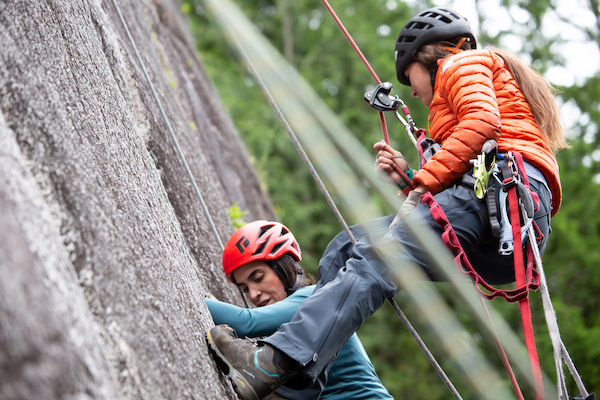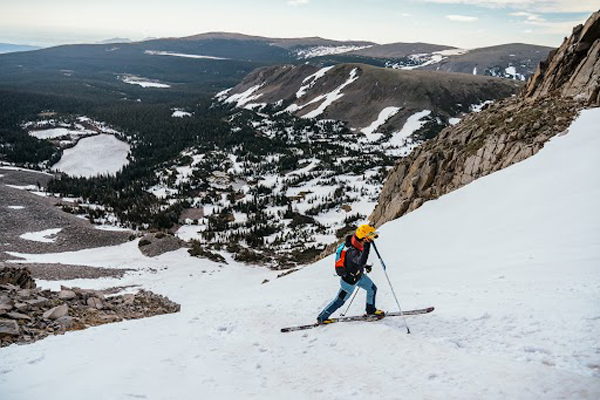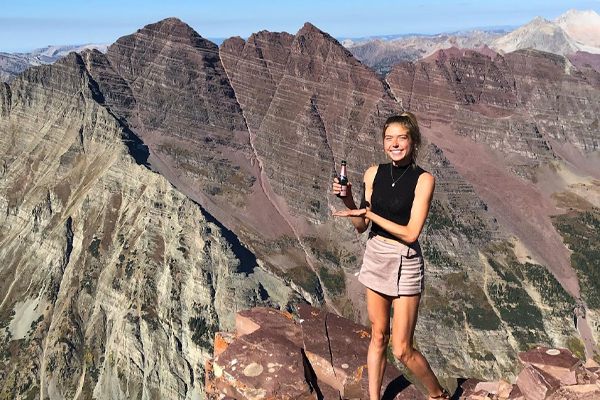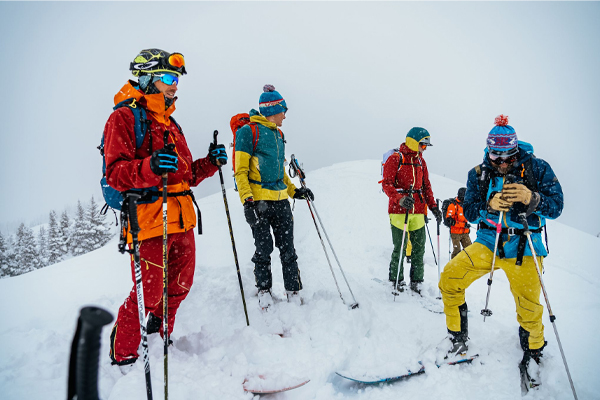Will Mayo - Apocalypse Now

We stood on the frozen surface, the sound of our guide’s sled faded amongst the howling gusts of wind...
- - -
On March 7, Anna Pfaff and I sent our “dream line” on the Cholesterol Wall, high above the east end of Ten Mile Pond in Gros Morne National Park, Newfoundland. This coveted line was a long-standing nemesis of our friend and mentor, Joe Terravecchia. Joe graciously shared the project with us when he learned that we were planning to visit Gros Morne, knowing we were hungry for the full engagement a hard traditional mixed project. At the end of February, Anna and I were laying plans to explore the northern reaches of the Park. The plan was to reconnoiter aerially and then fine-tune our objectives terrestrially by snowmobile and ski approaches. We were packing bivouac gear and logging coordinates on aviation charts when I received Joe’s photo of the central Cholesterol Wall. I gaped at the image that appeared on my screen, my phone clasped tightly in my sweating palm. Utter disbelief washed over me, the wall was what I have longed for precisely: a towering vertical precipice of granite stepped with overhangs draped with icicles and smears and capped with wild, three-dimensional daggers and roofs of ice.
Less than a week later, we stood on the frozen surface of Ten Mile Pond, as the sound of our departing snowmobile guide’s sled faded amongst the howling gusts of wind. Alone in the remote desolate heart of Gros Morne National Park, we shouldered our packs and made the steep approach up the snow-choked talus still wearing our parkas. Reaching the base after a half-hour’s post-holing exercise, we racked up with frozen fingers. The giant wall seemed insurmountable to us cowering amidst the sand-blast of spindrift-laden gusts. We resolved to break it down, focus on one pitch at a time, and thus avoid feeling overwhelmed by the enormity of the fiercely overhanging vastness that hung above our heads.
On the first day, we started up a rotting dike below the icicles in the center of the lower wall. I climbed up about 15 meters, finding several hard-won pieces of decent gear along the way before being stymied by horrid, unstable blocks of dike rock. I traversed left and climbed some delicate, parched, sun-baked icicles to try to end-run the ice. Again, I was shut down by a lack of gear. My fingers were completely numb in my skimpy dry-tooling gloves, my third tool flew out of my hand mid-swing when I was trying in vain to hammer in a knifeblade piton. I down-climbed to Anna, belaying patiently in the battering gusts at the base of the wall. Expecting her to lobby for a descent, she said, “What about the corner to the right?”
I warmed my hands in my mittens for fifteen minutes, racked up, and started up the corner. I was shocked to find solid, coarse granite in the corner and the opening section went quickly with good finger-sized Camalots for protection. I pulled up into a chimney, tagged a welded grey smear of ice, and stemmed up underneath the first ceiling. I pounded in a bomber angle piton, heel-hooked a horn on the right, and reached above the lip to find secure hooks in a fingertip-sized crack. The small wires slid into the crack at will, and I reached the second overhang as my hands began to numb. A finger-sized crack appeared above the ‘hang, I got gear, and committed to tenuous hooks in a corner that hung above. At precisely 30 meters, an ideal foot ledge was reached with gear available just above it. I built an anchor and yelled, “Off!” The first pitch (M8, 30 meters) was done and it was a knockout. We were on the wall, and the climbing was spectacular. Our morale soared.
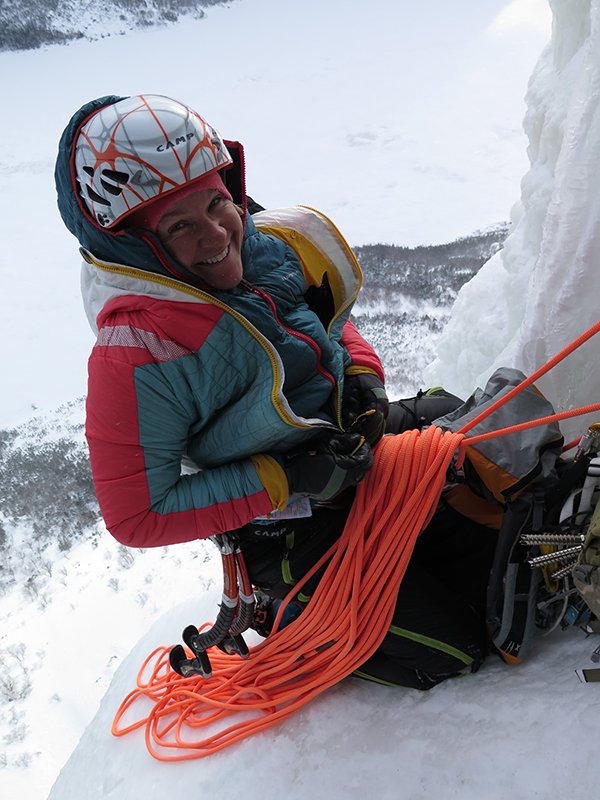
The second pitch (M8, 15 meters) required a bit more work. The intermittent seams that split the wall above were discontinuous and tight. I failed to on-sight it, and resolved to aid the pitch to get the gear and then climb it free. The gear consisted almost exclusively of peckers, tomahawks and knifeblades, but I cobbled it together after a full day’s effort. We pulled the rope, rappelled a line we fixed on the first pitch, and the next day, we sent it with the pitons in place. The free-climbing is excellent with tenuous hooks and pick torques in the seams and a delicate dance up delaminated smears of ice to reach the belay at a comfortable ledge below the wide sea of ice that hangs across the middle of the wall.
The third pitch (WI4, 40 meters) went quickly as well on our third day. We arrived at a snow pedestal below the surreal ice formations that hung above at mid-day. I continued up the fourth pitch (WI7, 35 meters) working out left, climbing a vertical step of ice, and was forced back right toward the frightening giant blobs of sun-baked ice that guarded the upper wall. Well above a good screw, I delicately worked up under the belly of the first formation. It resembled something out of the Chronicles of Narnia or The Grinch Who Stole Christmas, like a cartoonist’s bizarre creation. Like magic, a horizontal pin-crack appeared at the base of the ice. I pounded in a #6 knifeblade that rung with the unmistakable perfect ascending scale of rings of solidity. I thanked heaven, and committed to surmount the fearsome structure of ice and made my way upward above on plates of two-inch-thick dry, sun-bleached ice to find a belay on good angle pitons behind the doric column of ice that stands solitarily in the center of the upper wall below the ice roofs that loom above.
On our fourth day, we ascended the first two pitches on fixed ropes, re-climbed the ice of the third and fourth pitches, and got organized. We needed to traverse right to get to the rock corner beneath the menacing daggers of Joe’s nemesis. I tried a high rock traverse, but was stymied by completely compact granite, unable to find a single piece of gear. I climbed back to Anna belaying behind the column. With much trepidation, I started a low traverse on horrid shell-ice that covered a thin layer of hoar-snow that somehow clung to the vertical slab of featureless granite. Carefully, I kicked my crampons into the snow-ice and punched my picks through the shell-ice, hooking the eggshell, my picks bearing into the gypsum-like structure. Halfway across, I managed to find a seam in the rock above and placed a decent #1 knifeblade. I continued across and, finally, I reached a blob of ice on the aerie arete left of the base of the corner, placed a stubby screw and stepped right into the corner. With complete joy I found a solid crack on the right side of a giant flake that spanned the entire shallow chimney at the base of the corner that provided a solid anchor situated in a site out of the fall-line of the icicle that hung above the corner. I fixed a rope, and called the fifth pitch (WI5, 20 meters) done, and climbed back across the traverse to Anna’s belay. We rappelled from the fourth belay and regained our composure as we descended. This rig meant business, but now we were confident that it would go.
On the fifth day, we returned to the wall early, ascended our ropes and re-climbed the ice pitches and set up at the base of the corner. I racked up with frozen hands and a racing heart, knowing that this pitch was going to push me to the very edge. What followed is forever in my mind and memory locked. The pitch flowed, the gear opportunities kept coming, the tenuous hooks in the corner crack and seam held fast. Just when I would feel a sinking feeling of desperate doubt, I would get solid gear, my tool would find purchase. I pushed upward, stemming on tiny edges, the solid gear giving me the confidence needed to try hard without hesitation. A dream-like state overcame me, there were no thoughts anymore, only movements. I found myself hooking placements that would scare me if I had a bolt at my waist, but I was climbing virgin terrain on-sight above gear in a savage and remote location high up a frozen wall. I tapped the smears of sublimated ice on the arete on the right, I committed to the placements, went in with all of my chips . . . and it held. I reached the solid water-ice, and swung my tools into the succulent frozen water with so much force that I scared myself, my picks were buried to the welts. I found a protected stance on the right side of the column, placed five screws, and screamed in victorious rage, “OOOOOOOOOFFFFFF! WOOOOHOOOOOOOOOOOOOOOOOOOOOO!!!!!!!” I didn’t recognize the voice that echoed back at me from the walls across the pond seconds later. Anna screamed up at me, “DREAM LINE!!!!!!” and the sixth pitch (M9, 40 meters) was in the bag.
The seventh pitch (WI6, 40 meters) was the icing on the cake. The satisfaction of climbing the wind-tortured chandeliers at the top of this climb was one of the most joyful experiences of my life. Next, we are going to try to put together a direct line through the molars of the ice roof that caps the wall to the left of Apocalypse Now. Viva La Sportiva!





